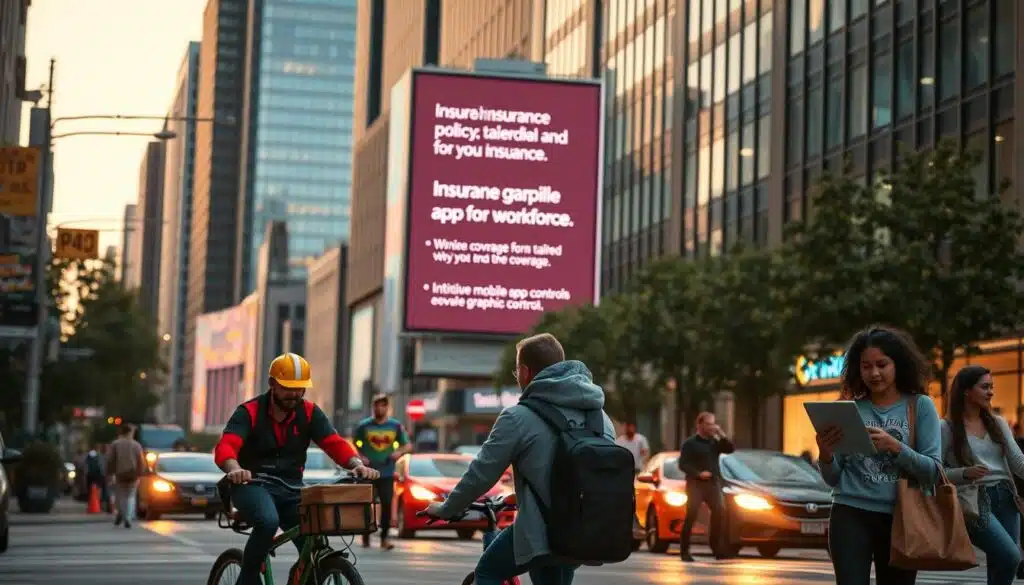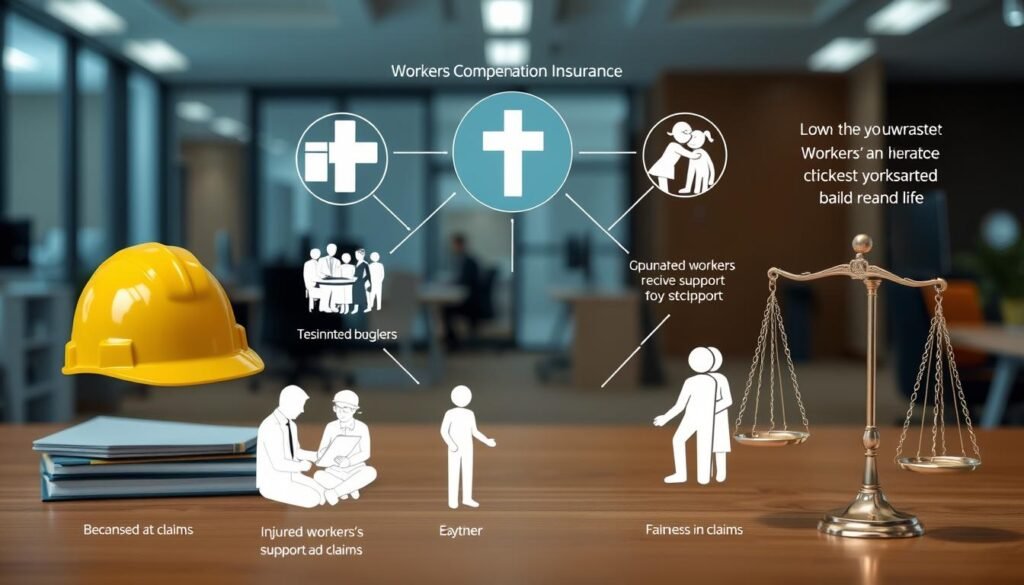Insurance for gig economy workers is your financial safety net for life’s unexpected curveballs—whether it’s a stolen laptop, a client lawsuit, or a sudden injury between paychecks. As traditional workplace benefits vanish, these tailored plans replace employer-backed security, letting you freelance fearlessly knowing a bad day won’t bankrupt your business.
Nearly 40% of U.S. workers now earn income through freelance projects or side hustles. This shift toward flexible work brings new challenges. These include unstable paychecks, uncovered medical costs, and vulnerable equipment.
Yet 2023 research reveals 68% of independent workers lack protection for these risks. This leaves them exposed to financial disaster.
Traditional workplace benefits like health plans or disability coverage rarely apply to gig workers. A single accident or stolen laptop could derail careers built over years. This gap creates urgent demand for tailored safety nets designed for modern work realities.
Specialized policies now address income dips during slow seasons, device replacements, and liability claims. Savvy freelancers combine these tools to build stability without sacrificing flexibility. The right mix acts as both shield and safety net, letting creators focus on growth.
Table of Contents
ToggleKey Notes;
- 40% of U.S. workers participate in freelance or gig work
- Over two-thirds lack adequate financial safeguards
- Income gaps and equipment losses pose top risks
- Custom plans replace outdated employer benefits
- Combining coverage types maximizes protection
Understanding the Gig Economy Landscape
Nearly 1 in 3 American workers now do gig work. They use platforms like DoorDash or freelance sites for money. This change brings new chances and challenges, like finding freelance worker insurance and on-demand worker coverage. Let’s explore this changing work world.
What is the Gig Economy?
The gig economy is a world of project-based work where people trade skills for income on their own terms—think driving for Uber, designing logos on Fiverr, or delivering groceries via DoorDash. It offers freedom to choose your hours and clients, but without traditional safety nets like health insurance or steady paychecks, leaving workers vulnerable to unexpected bumps in the road.
The gig economy links independent workers with short-term jobs online. It has two main types:
- Platform-based work: Companies like Uber or TaskRabbit handle clients and payments
- Independent freelancing: People sell their services directly on sites like Fiverr or through their networks
Delivery drivers usually work under platform rules. Creative folks often deal with clients on their own. This affects what insurance they need. Rideshare drivers need car insurance, while graphic designers might focus on liability insurance.
Growth Trends in Gig Workers
The gig sector grew 22% each year from 2020. This growth came from:
- Employers wanting flexible staff
- Workers wanting to choose their hours
- New tech in payment systems
| Work Type | Projected Growth | Common Insurance Needs |
|---|---|---|
| Delivery Services | 18% (2024-2027) | Commercial auto, accident coverage |
| Creative Freelance | 14% (2024-2027) | Errors & omissions, equipment protection |
Common Types of Gig Work
There are several main types of gig work:
- Mobility services: Rideshare drivers, food delivery people
- Digital freelancing: Programmers, writers, virtual assistants
- Skilled trades: Contract plumbers, event photographers
Each type faces different risks. Lyft drivers need car insurance that covers more than personal policies. Freelance developers need protection against cyber attacks. Knowing these risks helps workers pick the right on-demand worker coverage.
Why Gig Workers Need Insurance
Gig workers need insurance because they lack employer-provided protections. A single accident, lawsuit, or equipment loss can destroy their income and savings. Insurance covers these unexpected costs so their work remains sustainable.
In the gig economy, insurance is important. It’s not just a safety net. It’s the backbone of your business. Freelancers take on all risks by themselves. A single accident or lawsuit can stop your income for months.
Unique Risks for Freelancers
Gig workers face risks not seen by 9-to-5 folks. You might:
- Lose $15,000 worth of equipment to theft or damage (based on industry averages)
- Face lawsuits if a client trips over your photography gear at an event
- Accidentally breach client data during remote IT work
A Journal of Safety Research study found rideshare drivers have 23% more accidents than taxis. This risk is true for all gig workers, from food delivery to freelance consulting.
“Uninsured freelancers spend 3x more on legal fees than those with proper coverage.”
2024 Freelancer Financial Safety Report
Financial Implications of Being Uninsured
Imagine a wedding photographer facing a $42,000 lawsuit for a guest slipping on their cables. Without gig economy liability insurance, they used up savings and took loans to pay the claim.
Uninsured workers often face:
- Paying medical bills from client-site injuries out of pocket
- Replacing stolen work devices at full retail cost
- Losing income during equipment repair periods
Statutory Requirements for Coverage
23 states now require specific insurance for gig workers. Event venues often ask for $1M+ liability policies from vendors. Platforms like Upwork check for independent contractor insurance before approving big projects.
Key coverage needs by sector:
- Rideshare: Commercial auto insurance
- Freelance IT: Cyber liability coverage
- Event services: General liability policies
Don’t risk fines or lost contracts—check your state’s insurance rules every 6 months.
Types of Insurance for Gig Economy Workers
Independent workers face unique challenges when building financial safety nets. Three core insurance types form the foundation of protection: health coverage, liability safeguards, and income continuity plans. Choosing the right mix depends on your work type, income patterns, and risk exposure.
Health Insurance Options
Freelancers access healthcare through two primary channels: ACA marketplace plans and specialized gig economy providers. The Affordable Care Act offers standardized coverage tiers (Bronze to Platinum) with income-based subsidies. Platforms like Stride Health partner with insurers to create tailored plans for contractors, featuring:
- Flexible payment schedules matching irregular incomes
- Telemedicine integrations for busy professionals
- Tax deduction guidance for self-employed filers
| Feature | ACA Marketplace | Stride Health |
|---|---|---|
| Eligibility | All US residents | Gig workers only |
| Average Monthly Cost | $456 (unsubsidized) | $329-$518 |
| Special Features | Prescription coverage | Real-time subsidy calculator |
Liability Insurance Essentials
Professional liability coverage protects against client disputes and accidental damages. Most fields require minimum $1 million policies, though needs vary:
- Event performers: $1M+ for venue damages
- Consultants: Errors & Omissions coverage
- Delivery drivers: Commercial auto add-ons
Income Protection Policies
Short-term disability riders help bridge income gaps during unexpected absences. Look for plans with seasonal fluctuation allowances that adjust premiums based on project calendars. Photographers might choose weather-related clauses, while writers could add deadline extension protections.
Assessing Your Coverage Needs

Freelancers have special needs for insurance. It must fit your current and future work. Look at three main things: how much risk you can take, how stable your income is, and the dangers of your job. This way, your insurance grows with your career, not just stays the same.
Evaluating Personal Risk Factors
Every freelancer is different because of their job and life. Drivers might worry about accidents, while designers worry about computer problems. Make a list of what you need most:
| Gig Type | Primary Risk | Recommended Coverage |
|---|---|---|
| Rideshare Driver | Vehicle Damage | Commercial Auto + Liability |
| Freelance Writer | Equipment Theft | Portable Electronics Insurance |
| Event Photographer | Client Injury Claims | General Liability ($1M+) |
| IT Consultant | Data Breaches | Cyber Liability Insurance |
| Personal Trainer | Equipment Failure | Professional Liability + Gear Coverage |
Determining Appropriate Coverage Amounts
Use the Freelancer Coverage Formula: (Equipment Value + 6-Month Income) × Risk Factor. For example, a music producer with $15,000 worth of gear and $30,000 income:
- High-risk factor (1.5): ($15k + $30k) × 1.5 = $67,500 minimum coverage
- Low-risk writers: ($2k laptop + $20k income) × 1.0 = $22,000
Considering Industry-Specific Risks
Photography gear costs 43% more to replace than writing tools, reports say. Musicians need special coverage for their instruments. Make sure your policy covers:
- Off-site equipment use
- Client property damage
- Income loss during recovery periods
Pro Tip: Update your insurance values every quarter. Tools for gigs lose value fast. Get disability insurance and short-term income protection for full safety.
Popular Insurance Providers for Gig Workers
Finding the right insurance is vital. It must be affordable, cover your needs, and easy to use online. Insurers now make plans for gig workers. They consider your unpredictable work and project risks.
Let’s look at the top choices through four important areas: claim processing speed, payment flexibility, gig-specific protections, and app functionality.
Coverage Comparisons of Leading Brands
Big names like Next Insurance and Insureon are popular for freelancers. Next Insurance gives you instant proof of coverage. Insureon works with many carriers to meet your needs.
Here’s a quick comparison:
| Provider | Average Claim Time | Gig Endorsements | Mobile App Rating |
|---|---|---|---|
| Next Insurance | 2-3 days | Contractor liability | 4.8/5 |
| Insureon | 5-7 days | Consultant errors & omissions | 4.5/5 |
Hiscox | 3-5 days | Freelance cyber liability | 4.6/5 |
Niche Insurers Catering to Gig Workers
Some companies focus on what big providers miss. Thimble offers hourly or per-project policies for certain jobs. Slice Labs has active coverage for rideshare drivers.
These special options often include:
- No long-term contracts
- Pay-as-you-go billing
- Customizable liability limits
Customer Reviews and Satisfaction Ratings
What people say can help you decide. Next Insurance has a 4.7/5 Trustpilot score for its 24/7 claims portal. Thimble is known for its easy cancellation.
But, some common complaints are:
- Limited in-person agent support
- Restrictions on high-risk gigs
- Premium hikes after first claim
Always check if the company is financially stable before buying gig economy accident insurance.
The Role of Technology in Insurance Access

Now, tech makes getting insurance easier for freelancers. Digital tools help pick, manage, and file claims. This is key for those who work on their own and need flexible coverage.
Online Platforms for Insurance Comparison
AI tools help find the right insurance for freelancers. Policygenius and Coverwallet are leaders. They offer features just for those in the gig economy:
| Platform | Key Feature | Best For |
|---|---|---|
| Policygenius | Side-by-side quotes | Multi-policy bundling |
| Coverwallet | Industry-specific filters | Specialized liability coverage |
These tools save time by 60% compared to looking up insurance manually, reports say.
Mobile Apps for Managing Policies
Big insurers have apps for quick claims and changes. Lemonade’s app can handle claims in 90 seconds with AI. Freelancers like these apps for:
- Policy updates during work hours
- Digital proof of insurance
- Usage-based premium calculations
Benefits of Digital Insurance Solutions
Cloud-based systems offer three main benefits for freelancers:
- 24/7 access to policy documents
- Automated renewals with rate alerts
- Integrated tax tools for deductible tracking
These tools help freelancers keep coverage up while their income changes.
Tips for Finding Affordable Coverage
Finding cheap independent contractor insurance needs smart planning. You can get good coverage without spending too much. Here are three ways to cut costs while keeping quality high.
Bundling Insurance Policies
Getting many policies from one place can save a lot. Try this three-step plan:
- Core coverage: Health + liability insurance (base protection)
- Seasonal add-ons: Equipment insurance when you work a lot
- Catastrophic safeguards: Disability insurance for big emergencies
Many insurers give 10-25% off for bundling. A study found freelancers save $612/year by bundling wisely.
Utilizing Discounts and Offers
Here are seven ways to lower your insurance costs:
- Professional association membership discounts (Up to 15% off)
- Claim-free history rewards (5% annual reduction)
- Annual payment vs monthly installments (3-7% savings)
- Wellness program participation (Health insurance specific)
- Early sign-up incentives for new customers
- Multi-year policy commitments
- Referral bonuses for bringing in other freelancers
Leveraging Freelance Networks for Recommendations
Groups for freelancers can get you better rates. The Freelancers Union got 22% lower premiums for 8,300 members in 2023 through group bargaining.
“Our network’s group health plan cut my premiums by $148/month compared to individual market rates.”
– Marketing Consultant, Freelancers Union Member
Join groups in your field and:
- Compare verified provider reviews
- Access member-only insurance marketplaces
- Share cost-saving strategies in forums
Working with Insurance Brokers
Freelancers often face tough insurance choices. Working with a broker helps a lot. They offer custom solutions for freelancers, using their knowledge and doing risk checks.
This makes it easier to find the right coverage. It saves time and money too.
When to Seek Professional Help
Insurance brokers are very helpful in these situations:
- Multi-state operations: They help with different insurance rules in each state.
- High-value equipment: They insure special tools or tech that’s more than usual.
- Crew hiring: They handle liability for temporary teams or subcontractors.
- Contract-specific requirements: They make sure you meet client coverage needs.
- Industry niches: They deal with special risks in areas like photography or consulting.
Questions to Ask an Insurance Broker
Here’s a 12-question checklist for your meeting:
- What policy exclusions apply to home studio use?
- How does coverage change with income?
- Are equipment replacements based on ACV or full replacement cost?
- What makes a professional liability claim valid?
- How fast can policy changes happen?
- What documents help with claim approvals?
“Gig workers often don’t realize the big difference between Actual Cash Value and full replacement costs. Always check how they value things in writing.”
Gooding Brown & Company Advisory
Mistakes to Avoid in Coverage Selection
Don’t make these mistakes:
- Choosing general policies instead of ones made for freelancers
- Not getting business interruption insurance
- Thinking personal auto insurance covers gig-related travel
Brokers like those at Gooding Brown & Company say to review your policy every year. This is because your equipment or services might change. This way, your insurance keeps up with your career.
Navigating Claims and Coverage Disputes
When gig workers face insurance challenges, knowing how to handle claims and disagreements becomes critical. Over 40% of freelancers report at least one coverage dispute in their careers. This is often due to misunderstandings about policy terms. Preparing ahead and keeping clear records can greatly improve your chances of success.
Understanding the Claims Process
Follow this 8-step timeline to streamline claims for gig economy liability insurance:
- Immediate Documentation: Record incident details within 24 hours
- Policy Review: Verify coverage scope in your contract
- Claim Submission: File through insurer’s portal or app
- Adjuster Assignment: Typically within 3 business days
- Evidence Submission: Provide photos, receipts, contracts
- Initial Response: Expect within 10-14 days
- Resolution Offer: Review payment calculations carefully
- Final Settlement: Average processing takes 21-45 days
Common Reasons for Claim Denials
Recent industry data shows these top denial causes for gig workers:
| Denial Reason | Percentage | Prevention Tip |
|---|---|---|
| Undocumented Equipment Use | 32% | Photograph work tools before projects |
| Premium Lapses | 28% | Set automatic payment reminders |
| Excluded Perils | 19% | Review policy exclusions annually |
| Missed Deadlines | 15% | Use calendar alerts for claims |
| Incomplete Forms | 6% | Use insurer-provided checklists |
Steps to Take If Your Claim is Denied
When facing denial, act strategically:
- Request Detailed Explanation: Insurers must provide denial reasons in writing
- Gather Supporting Evidence: Collect time-stamped documents and witness statements
- Submit Formal Appeal: Include these key components:
- Policy number and claim reference
- Point-by-point rebuttal of denial reasons
- New supporting evidence
- Notarized affidavits if available
- Escalate to State Insurance Department: Available after 30-day internal review
“Always request claim denials in writing – verbal rejections hold no legal weight. Paper trails protect your rights.”
National Association of Insurance Commissioners
Staying Up-to-Date with Insurance Regulations

Freelancers face a changing world of rules. New laws and updates affect how they handle risks and follow rules. For example, the 2024 IRS Form 1099-K now tracks payments as low as $600. This is key for taxes and insurance claims.
Changes in Insurance Laws Affecting Gig Workers
New laws bring both challenges and chances. The updated 1099-K rules mean freelancers must keep better records. This is for health insurance and disability claims. State rules also change often:
| Regulation | 2023 Status | 2024 Update |
|---|---|---|
| 1099-K Threshold | $20,000 | $600 |
| Independent Contractor Classification | State Varies | Federal ABC Test |
| Health Insurance Subsidies | Marketplace Only | Freelancer Union Partnerships |
Importance of Reviewing Your Policy Regularly
Check your insurance every three months to avoid gaps. Here’s a simple guide:
- Compare policy dates with your projects
- Make sure liability limits match client contracts
- Update your equipment list for property coverage
Resources for Ongoing Education and Updates
Seven trusted sources help freelancers stay informed:
- Department of Labor Gig Worker Portal
- IRS Self-Employed Tax Center
- National Association of Insurance Commissioners
- Freelancers Union Compliance Alerts
- State Insurance Department Websites
- Industry-Specific Trade Associations
- Certified Financial Planner Networks
Save these resources and set reminders for yearly policy checks. Staying ahead means your insurance keeps up with laws and protects your income.
The Future of Insurance for Gig Workers
The insurance world for independent workers is changing fast. New solutions are coming up to cover risks that were missed before. They also fit with the new ways of working that are changing jobs all over the world.
Emerging Trends in Coverage Options
Platforms like Slice and Trov offer insurance for short-term projects. They let freelancers get protection for just the time they need it. Parametric insurance is also getting popular. It pays out automatically when certain things happen, like if you can’t work because of an injury.
Now, there are health insurance plans for people who work in different countries. SafetyWing is one company that offers this kind of coverage. It helps digital nomads get health insurance no matter where they are.
The Impact of Remote Work on Insurance Needs
Working from home or in a mix of places can be tricky. Insurers are making special packages for this. They cover things like your home office, cyber risks, and injuries from sitting too much.
Next Insurance is one company that offers insurance that works anywhere in the US. It’s made for people who work in different places.
Predictions for the Gig Economy Insurance Market
Experts think the market for insurance for gig workers will grow by 30% by 2027. This is because more freelance platforms are adding insurance options. Soon, AI will help figure out how much insurance you need based on how you work.
Big insurance companies like Allstate and Liberty Mutual are teaming up with more places. They want to offer insurance that fits your needs when you start a new job. Keep an eye on the Freelancers Union and InsureTech Connect for updates. Make sure your insurance stays up to date with your work life. Talk to insurance experts who know about non-traditional work to protect your money.










